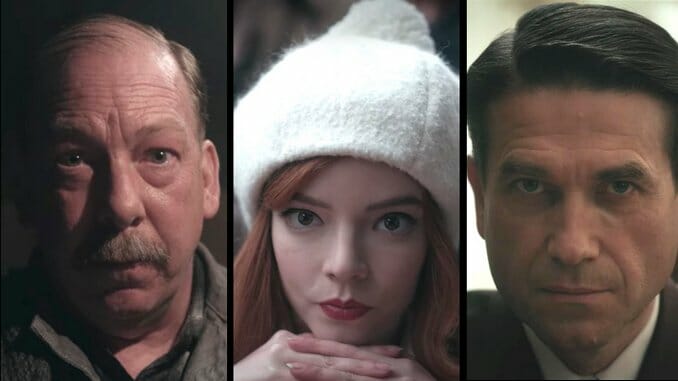The Queen’s Gambit Makes Me Want to Spend Hours Staring at Chess Faces
Photos Courtesy of Netflix
I could spend all day raving about Netflix’s fantastic new series The Queen’s Gambit, but our TV Editor Allison Keene already nailed both its quality and the fact that it’s secretly one of the best sports stories ever told on TV. If you’re a binge watcher, don’t even bother starting it unless you have 7 of your next … oh, 9.5 hours free. It’s irresistible. Today, though, I want to talk about one specific element that has me slightly obsessed, and which I will now capitalize in my attempt to make it a legitimate thing: The Chess Face.
I have watched real professional chess before. Not a lot; maybe three hours cumulatively in an entire lifetime. Still, it’s enough to report that in the real world, grandmasters spend most of their time staring at the board looking pensive at best, miserable at worst, slouched and with their face squeezed into ugly contortions by their hands. As far as I have been able to tell, there is not a lot of gazing into each other’s faces, communicating mystery, defiance, respect, the proper hint of arrogance, and a kind of flirtatious challenge. But The Queen’s Gambit eschews the trappings of actual chess and gives us something far better: the noble Chess Face.
It’s hard to convey how much I enjoyed this element of the show, so let me show you two chess faces. As it happens, these are the last two shots of the entire series, the first from a character you don’t need to know, the last from Anya Taylor-Joy, who stars as Beth Harmon and who, as the aforementioned Allison Keene pointed out to me, is approximately “1/3 eyes.”


Do you see it? Do you see the inherent human and competitive drama written on their faces, the intensity and the joy of this game they’re playing? Or am I starting to scare you? Let me promise you something, my friend: Before we leave here today, you are either going to understand the shattering, ephemeral art of The Chess Face, or you will file a restraining order.
One of the elements that makes TQG such a strong show is the elaborate, ornate set pieces that are vaguely reminiscent of Wes Anderson and will make you wish you lived about 50 years ago and had the means to trot the globe staying at fancy hotels. The chess venues are some of the most beautiful examples of TV stagecraft I’ve seen, and director Scott Frank gets incredible mileage out of taking us into these baroque, colorful worlds before tightening his frame, softening the background, and letting the light and shadow highlight … you guessed it, The Chess Face. Often, the expressions are enigmatic, but not always. Look, for instance, at this dewy-eyed soul:

Even in that scene, as a British announcer tells us that the man was respectful in his loss, you can see the heartache and hopelessness he feels at his defeat. Even in its least subtle forms, The Chess Face gives us multitudes.
Taylor-Joy is wonderful in all aspects, but I suspect that if she didn’t have a compelling fact that could credibly be called “magnetic,” she never could have carried the role. Hers is the Chess Face of Chess Faces, the palate on which the entire drama must rest, and she’s more than up to the job. When the camera comes close, you can see in the flash of her eyes, in the little uptick in the corner of a mouth, in the illumination across the whole face, that the human being formerly known as poor Beth Harmon, the orphan, the addict, has come alive, is no longer a victim, is a wry shark in churning waters, in love with her own power. Remember that unflattering pose I spoke about earlier, from real-life chess? She even makes that look good:

-

-

-

-

-

-

-

-

-

-

-

-

-

-

-

-

-

-

-

-

-

-

-

-

-

-

-

-

-

-

-

-

-

-

-

-

-

-

-

-












































